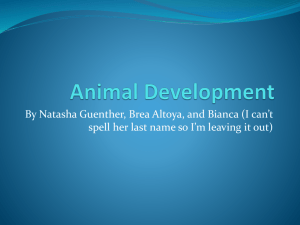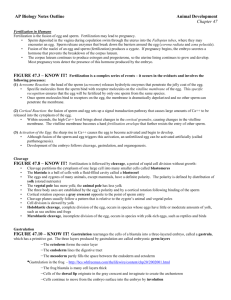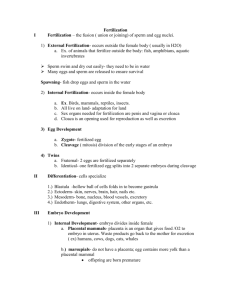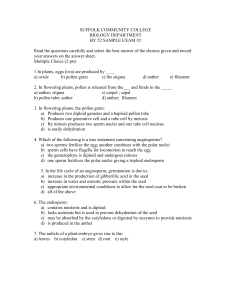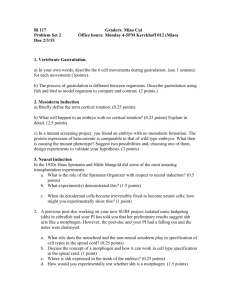Development
advertisement
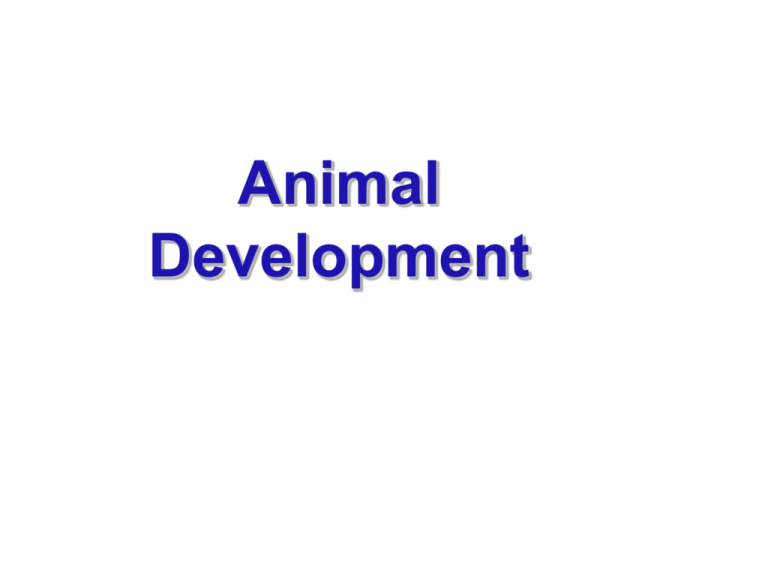
Animal Development • The question of how a zygote becomes an animal has been asked for centuries • As recently as the 18th century, the prevailing theory was called preformation • Preformation is the idea that the egg or sperm contains a miniature infant, or “homunculus,” which becomes larger during development WHAT DETERMINES DEVELOPMENT • Development is determined by the zygote’s genome and differences between embryonic cells • Cell differentiation is the specialization of cells in structure and function • Morphogenesis is the process by which an animal takes shape Big ideas Gametes (fertilizaiton) Zygote (cleavage) Blastula (gastrulation) Gastrula (neurulation) Organogenesis Role of genes & protein concentration gradients • Induction: communication from an inducer to a competent responder • • • • • • • Fertilization • 2 major events: • Fertilization brings the haploid nuclei of sperm and egg together, forming a diploid zygote • The sperm’s contact with the egg’s surface initiates metabolic reactions in the egg that trigger the onset of embryonic development • Most info comes from sea urchin studies – External fertilization – Problems of external fertilization: • Dilution/protection of gametes in the enormous volume of the ocean • Correct species fertilization • Blocking polyspermy The Acrosomal Reaction • The acrosomal reaction is triggered when the sperm meets the egg • This reaction releases hydrolytic enzymes that digest material surrounding the egg • Acrosomal process adheres to receptors on vitelline layer (species specific) – Sperm/egg membranes fuse, sperm nucleus enters – Na+ influx, depolarization – Depolarization sets up fast block to polyspermy Fast block polyspermy Contact and fusion of sperm and egg membranes Acrosomal reaction Sperm plasma membrane Contact Basal body (centriole) Entry of sperm nucleus Sperm nucleus Cortical reaction Acrosomal process Sperm head Actin Acrosome Jelly coat Sperm-binding receptors Fertilization envelope Fused plasma Cortical membranes granule Hydrolytic enzymes Perivitelline space Vitelline layer Egg plasma membrane EGG CYTOPLASM Cortical granule membrane The Cortical Reaction • Fusion of egg and sperm also initiates the cortical reaction • This reaction induces a rise in Ca2+ in cytoplasm that stimulates cortical granules to release their contents outside the egg • Cortical granules fuse w/ membrane – Enzymes – Polysaccharides – Fertilization envelope formed = slow block to polyspermy (follows repolarization) • These changes cause formation of a fertilization envelope that functions as a slow block to polyspermy Fast block polyspermy 500 µm 1 sec before fertilization 10 sec after fertilization Point of sperm entry 20 sec Spreading wave of calcium ions 30 sec Activation of the Egg • The sharp rise in Ca2+ in the egg’s cytosol increases the rates of cellular respiration and protein synthesis by the egg cell – Chemical signals from cortical rxn cause H+ to be transported out --> increase in pH • Nuclei fuse • Egg/sperm differences – Egg contains proteins, mRNA not found in sperm – Ca2+ injection, temperature shock can cause artificial activation • With these rapid changes in metabolism, the egg is said to be activated Minutes Seconds LE 47-5 1 Binding of sperm to egg 2 3 4 Acrosomal reaction: plasma membrane depolarization (fast block to polyspermy) 6 8 10 Increased intracellular calcium level 20 Cortical reaction begins (slow block to polyspermy) 30 40 50 1 Formation of fertilization envelope complete 2 Increased intracellular pH 3 4 5 Increased protein synthesis 10 20 30 40 60 90 Fusion of egg and sperm nuclei complete Onset of DNA synthesis First cell division Fertilization in Mammals • In mammalian fertilization, the cortical reaction modifies the zona pellucida as a slow block to polyspermy LE 47-6 Follicle cell Zona pellucida Egg plasma membrane Acrosomal vesicle Sperm Cortical basal ganules body Sperm nucleus EGG CYTOPLASM Cleavage • Fertilization is followed by cleavage, a period of rapid cell division without growth • Cleavage partitions the cytoplasm of one large cell into many smaller cells called blastomeres LE 47-7 Fertilized egg Four-cell stage Morula Blastula • The eggs and zygotes of many animals, except mammals, have a definite polarity • The polarity is defined by distribution of yolk, with the vegetal pole having the most yolk • The development of body axes in frogs is influenced by the egg’s polarity LE 47-8 Point of sperm entry Animal hemisphere Vegetal hemisphere Point of sperm entry Anterior Right Ventral Gray crescent Vegetal pole Future dorsal side of tadpole First cleavage Dorsal Left Posterior Body axes Animal pole Establishing the axes • Cleavage planes usually follow a pattern that is relative to the zygote’s animal and vegetal poles LE 47-9 Zygote 0.25 mm 2-cell stage forming 4-cell stage forming Eight-cell stage (viewed from the animal pole) 8-cell stage 0.25 mm Animal pole Blastula (cross section) Blastocoel Vegetal pole Blastula (at least 128 cells) • Meroblastic cleavage, incomplete division of the egg, occurs in species with yolk-rich eggs, such as reptiles and birds LE 47-10 Fertilized egg Disk of cytoplasm Zygote Four-cell stage Blastoderm Cutaway view of the blastoderm Blastocoel BLASTODERM YOLK MASS Epiblast Hypoblast • Holoblastic cleavage, complete division of the egg, occurs in species whose eggs have little or moderate amounts of yolk, such as sea urchins and frogs Gastrulation • Gastrulation rearranges the cells of a blastula into a three-layered embryo, called a gastrula, which has a primitive gut • The three layers produced by gastrulation are called embryonic germ layers – The ectoderm forms the outer layer – The endoderm lines the digestive tract – The mesoderm partly fills the space between the endoderm and ectoderm Video: Sea Urchin Embryonic Development • The mechanics of gastrulation in a frog are more complicated than in a sea urchinINVAGINATION • OTHERS- INVOLUTION LE 47-12 CROSS SECTION SURFACE VIEW Animal pole Blastocoel Vegetal pole Dorsal lip of blastopore Dorsal tip of blastopore Blastula Blastocoel shrinking Archenteron Ectoderm Mesoderm Endoderm Blastocoel remnant Key Future ectoderm Future mesoderm Future endoderm Yolk plug Yolk plug Gastrula • Gastrulation in the chick and frog is similar, with cells moving from the embryo’s surface to an interior location • During gastrulation, some epiblast cells move toward the blastoderm’s midline and then detach and move inward toward the yolk. INVOLUTION LE 47-13 Epiblast Primitive streak Future ectoderm Endoderm Migrating cells (mesoderm) Hypoblast YOLK Organogenesis • During organogenesis, various regions of the germ layers develop into rudimentary organs organs • Early in vertebrate organogenesis, the notochord forms from mesoderm, and the neural plate forms from ectoderm Video: Frog Embryo Development LE 47-14a Neural folds LM 1 mm Neural Neural fold plate Notochord Ectoderm Mesoderm Endoderm Archenteron Neural plate formation LE 47-14b Neural fold Neural plate Neural crest Outer layer of ectoderm Neural crest Neural tube Formation of the neural tube The neural plate soon curves inward, forming the neural tube LE 47-14c Somites Eye SEM Neural tube Notochord Coelom Archenteron (digestive cavity) Somites Tail bud 1 mm Neural crest Somite •Mesoderm lateral to the notochord forms blocks called somites •Lateral to the somites, the mesoderm splits to form the coelom LE 47-15 Eye Neural tube Notochord Forebrain Somite Heart Coelom Archenteron Endoderm Mesoderm Lateral fold Blood vessels Ectoderm Somites Yolk stalk YOLK Yolk sac Form extraembryonic membranes Early organogenesis Neural tube Late organogenesis •Many structures are derived from the three embryonic germ layers during organogenesis Developmental Adaptations of Amniotes • Embryos of birds, other reptiles, and mammals develop in a fluid-filled sac in a shell or the uterus • Organisms with these adaptations are called amniotes • In these organisms, the three germ layers also give rise to the four membranes that surround the embryo LE 47-17 Amnion Allantois Embryo Amniotic cavity with amniotic fluid Albumen Shell Yolk (nutrients) Chorion Yolk sac Mammalian Development • The eggs of placental mammals – Are small and store few nutrients – Exhibit holoblastic cleavage – Show no obvious polarity • Gastrulation and organogenesis resemble the processes in birds and other reptiles • Early cleavage is relatively slow in humans and other mammals • At completion of cleavage, the blastocyst forms • The trophoblast, the outer epithelium of the blastocyst, initiates implantation in the uterus, and the blastocyst forms a flat disk of cells • As implantation is completed, gastrulation begins • The extraembryonic membranes begin to form • By the end of gastrulation, the embryonic germ layers have formed-ECTODERM, MESODERM AND ENDODERM LE 47-18a Endometrium (uterine lining) Inner cell mass Trophoblast Blastocoel Blastocyst reaches uterus. Maternal blood vessel Expanding region of trophoblast Epiblast Hypoblast Trophoblast Blastocyst implants. LE 47-18b Expanding region of trophoblast Amniotic cavity Amnion Epiblast Hypoblast Chorion (from trophoblast Yolk sac (from hypoblast) Extraembryonic membranes start to form and gastrulation begins. Extraembryonic mesoderm cells (from epiblast) Allantois Amnion Chorion Ectoderm Mesoderm Endoderm Yolk sac Extraembryonic mesoderm Gastrulation has produced a three-layered embryo with four extraembryonic membranes. • The extraembryonic membranes in mammals are homologous to those of birds and other reptiles and develop in a similar way Morphogenesis in animals involves specific changes in cell shape, position, and adhesion • Morphogenesis is a major aspect of development in plants and animals • But only in animals does it involve the movement of cells The Cytoskeleton, Cell Motility, and Convergent Extension • Changes in cell shape usually involve reorganization of the cytoskeleton • Microtubules and microfilaments affect formation of the neural tube LE 47-19 Ectoderm Neural plate • The cytoskeleton also drives cell migration, or cell crawling, the active movement of cells • In gastrulation, tissue invagination is caused by changes in cell shape and migration • Cell crawling is involved in convergent extension, a morphogenetic movement in which cells of a tissue become narrower and longer LE 47-20 Roles of the Extracellular Matrix and Cell Adhesion Molecules • Fibers of the extracellular matrix may function as tracks, directing migrating cells along routes • Several kinds of glycoproteins, including fibronectin, promote cell migration by providing molecular anchorage for moving cells LE 47-21 Direction of migration 50 µm • Cell adhesion molecules contribute to cell migration and stable tissue structure • One class of cell-to-cell adhesion molecule is the cadherins, which are important in formation of the frog blastula LE 47-22 Control embryo Experimental embryo The developmental fate of cells depends on their history and on inductive signals • Coupled with morphogenetic changes, development requires timely differentiation of cells at specific locations • Two general principles underlie differentiation: – During early cleavage divisions, embryonic cells must become different from one another – After cell asymmetries are set up, interactions among embryonic cells influence their fate, usually causing changes in gene expression Fate Mapping • Fate maps are general territorial diagrams of embryonic development • Classic studies using frogs indicated that cell lineage in germ layers is traceable to blastula cells LE 47-23a Epidermis Epidermis Central nervous system Notochord Mesoderm Endoderm Blastula Fate map of a frog embryo Neural tube stage (transverse section) • Techniques in later studies marked an individual blastomere during cleavage and followed it through development LE 47-23b Cell lineage analysis in a tunicate Establishing Cellular Asymmetries • To understand how embryonic cells acquire their fates, think about how basic axes of the embryo are established The Axes of the Basic Body Plan • In nonamniotic vertebrates, basic instructions for establishing the body axes are set down early, during oogenesis or fertilization • In amniotes, local environmental differences play the major role in establishing initial differences between cells and, later, the body axes Restriction of Cellular Potency • In many species that have cytoplasmic determinants, only the zygote is totipotent • That is, only the zygote can develop into all the cell types in the adult • Unevenly distributed cytoplasmic determinants in the egg cell help establish the body axes • These determinants set up differences in blastomeres resulting from cleavage LE 47-24 Right (experimental): Left (control): Fertilized eggs were Fertilized constricted by a salamander eggs thread so that the were allowed to first cleavage plane divide normally, restricted the gray resulting in the crescent to one gray crescent blastomere. being evenly divided between the two blastomeres. Gray crescent Gray crescent The two blastomeres were then separated and allowed to develop. Normal Belly piece Normal • As embryonic development proceeds, potency of cells becomes more limited Cell Fate Determination and Pattern Formation by Inductive Signals • After embryonic cell division creates cells that differ from each other, the cells begin to influence each other’s fates by induction The “Organizer” of Spemann and Mangold • Based on their famous experiment, Spemann and Mangold concluded that the blastopore’s dorsal lip is an organizer of the embryo • The organizer initiates inductions that result in formation of the notochord, neural tube, and other organs LE 47-25a Pigmented gastrula (donor embryo) Dorsal lip of blastopore Nonpigmented gastrula (recipient embryo) LE 47-25b Primary embryo Secondary (induced) embryo Primary structures: Neural tube Notochord Secondary structures: Notochord (pigmented cells) Neural tube (mostly nonpigmented cells) Formation of the Vertebrate Limb • Inductive signals play a major role in pattern formation, development of spatial organization • The molecular cues that control pattern formation are called positional information • This information tells a cell where it is with respect to the body axes • It determines how the cell and its descendents respond to future molecular signals • The wings and legs of chicks, like all vertebrate limbs, begin as bumps of tissue called limb buds LE 47-26a Anterior AER Limb bud ZPA Posterior Apical ectodermal ridge Organizer regions 50 µm • The embryonic cells in a limb bud respond to positional information indicating location along three axes LE 47-26b Digits Anterior Ventral Proximal Dorsal Wing of chick embryo Distal Posterior • One limb-bud organizer region is the apical ectodermal ridge (AER) • The AER is thickened ectoderm at the bud’s tip • The second region is the zone of polarizing activity (ZPA) • The ZPA is mesodermal tissue under the ectoderm where the posterior side of the bud is attached to the body • Tissue transplantation experiments support the hypothesis that the ZPA produces an inductive signal that conveys positional information indicating “posterior” LE 47-27 Anterior Donor limb bud New ZPA Host limb bud ZPA Posterior • Signal molecules produced by inducing cells influence gene expression in cells receiving them • Signal molecules lead to differentiation and the development of particular structures

